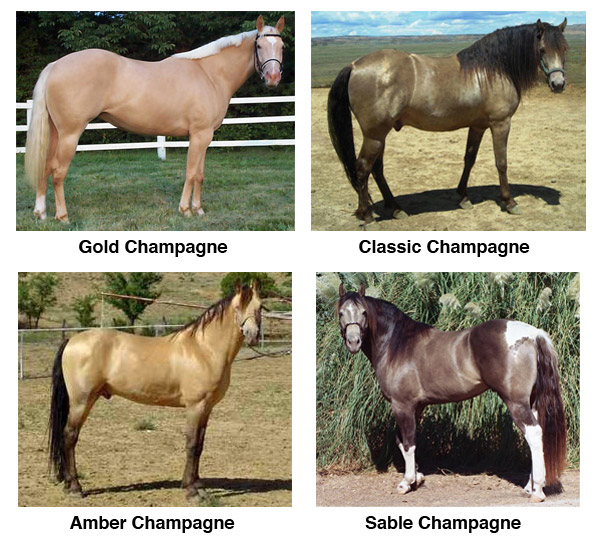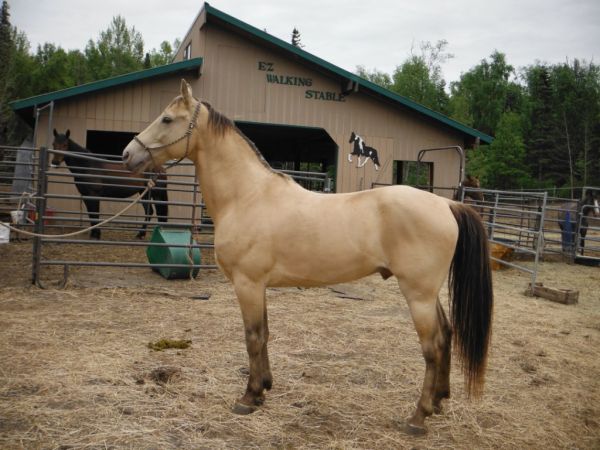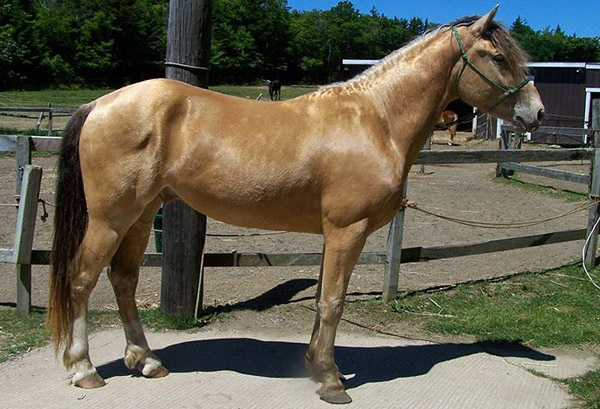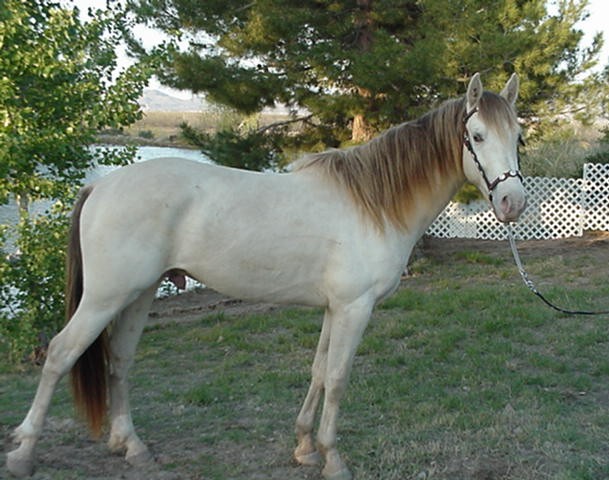Champagne gene
As Champagne is called the color of a horse, which was brightened by the Champagne gene. Depending on the underlying color they are golden with white or chocolate- colored mane or they have the typical Champagnefarbe with slightly darker mane and tail.
Appearance
The coat has often, but not always, a metallic sheen. Black is faded to chocolate brown to mane and tail and slightly lighter on the body. Brown skin is golden and almost white on the body in the mane. The coat of the foal is usually darker than it will be in the adult animal later.
Horses of Color Champagne are born with pink skin that gets dark spots within the first days of life. Adult animals still have pink skin with dark spots, but in places that are exposed to the sun, darker with the years. At birth, the eyes of the foals are blue, lighter in the first days of life and then darken over the years. You get the time a hazelnut brown or slightly greenish color.
Classic Champagne
As a Classic Champagne Rappe is called, which was brightened by the Champagne gene. It acts on the body sometimes more gray, sometimes the color goes into a little gray -brown. Mane and tail are darker than the body but not black but dark brown.
Possibility of confusion: The Mausfalbe differs from the Classic Champagne with dark brown eyes, often bi-colored mane its middle hair is black and the black skin.
Amber Champagne
When Amber Champagne is called a brightened by the Champagne gene Brauner. His coat has a golden color, but can be as dark never that one could confuse the animal with a normal brown. Mane and tail are dark brown.
As Sable Champagne a brightened by the Champagne- Gen Black Brown is called. His coat has a brown - golden color. Mane and tail are also dark.
Possible confusion:
- Braunfalbe: It differs by the darker skin, darker eyes and two colored mane, whose middle hair is black.
- Buckskin: Differs by his dark skin and the darker mane.
Gold Champagne
The Gold Champagne is a brightened by the gene fox. His coat may be of gold or something lighter, but is never so dark that you could confuse it with a fox with Flaxen.
Possibility of confusion: The Isabelle is distinguished by its darker skin from Champagne Gold.
Double brightened by Champagne
Horses that have double wear the Champagne gene as adult animals completely pink skin with less than half as many dark spots as heterozygous. Since both cases are known brightened foxes, it is unclear to what extent the appearance of lightened brown and black horses is different from the yellowish white of the double brightened foxes. Here, however, is debatable whether the above cases are not yet arisen gene from the combination of Pearl and Cream and will not interact with the champagne gene. Since the latter is a dominant gene should be visible no differences for heterozygous carrier animals. See " Interaction".
Interactions with other genes
Breeds
The color of Champagne occurs with the following breeds: American Miniature Horse, American Quarter Horse, American Paint Horse, American Saddlebred, Appaloosa, Missouri Fox Trotter, Spanish Mustang, Spotted Saddle Horse, Tennessee Walking Horse, Half- Arabians. American Cream Draft Horses are all brightened by Champagne foxes.
Genetics
The Champagne gene ( Chc ) is located on chromosome ECA14 and is a mutation in the SLC36A1 gene ( Solute carrier family 36 A1) and PAT1 ( proton / amino acid transporter 1) or LYAAT1 ( lysosomal amino acid transporter 1) called will.
The gene encodes a transporter of the amino acids and protons transported across membranes. This transporter is believed to be responsible for them in the Melanosomenvorstufen the correct pH for melanin production. The brighter color of the affected horses probably comes from the fact that the pH of melanosomes is set with the horses wrong with the mutation and thus the production of melanin does not function properly.
The illumination of the gene is inherited as an intermediate. That is, animals that double carry the gene are slightly more lightened, have a lighter eye color and have less dark dots on the pink skin. However, the characteristics of the homozygous color overlap with heterozygous expression and are difficult to distinguish, so it is often said, the color would dominantly inherited.










